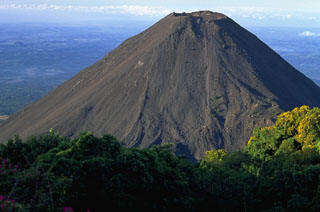Report on Izalco (El Salvador) — December 1999
Bulletin of the Global Volcanism Network, vol. 24, no. 12 (December 1999)
Managing Editor: Richard Wunderman.
Izalco (El Salvador) Fumaroles active 35 years ago now emitting water vapor at 86°C
Please cite this report as:
Global Volcanism Program, 1999. Report on Izalco (El Salvador) (Wunderman, R., ed.). Bulletin of the Global Volcanism Network, 24:12. Smithsonian Institution. https://doi.org/10.5479/si.GVP.BGVN199912-343030
Izalco
El Salvador
13.813°N, 89.633°W; summit elev. 1950 m
All times are local (unless otherwise noted)
Izalco's summit crater was visited to examine the fumarole field that was the site of many geochemical and mineralogical studies in the 1960's and 1970's. The remaining fumaroles consist only of water vapor with a maximum temperature of 86°C.
Volcan de Izalco originated in 1770 A.D. on the S flank of Santa Ana volcano. Frequent Strombolian eruptions from the volcano, known as the "Lighthouse of Central America," produced a 650-m-high stratovolcano within 200 years.
Geological Summary. Volcán de Izalco began growing in 1770 CE on the southern flank of Santa Ana volcano, eventually building a steep 650-m-high stratovolcano truncated by a 250-m-wide summit crater. Frequent Strombolian eruptions during the two centuries prior to the cessation of activity in 1966 provided a night-time beacon for ships, causing it to be known as El Faro, the "Lighthouse of the Pacific." The dominantly basaltic andesite tephra and lava flows are geochemically distinct from those of both Santa Ana and its fissure-controlled flank vents. Lava flows have primarily erupted from flank vents, traveling as far as about 7 km south down the slopes of Santa Ana.
Information Contacts: Alain Bernard, BRUGEL, Université Libre de Bruxelles 160/02 50, Ave. Roosevelt, 1050 Brussels, Belgium.

